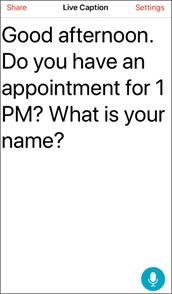The ongoing COVID-19 pandemic has touched nearly every aspect of our lives, including how we interact with patients. At this point, it is almost hard to remember a time when we didn’t have to wear masks during clinical encounters. Though universal masking has quickly become a necessary reality to prevent the spread of the virus, it presents a unique challenge for those who are hearing impaired.
With the use of masks, we remove visual cues and degrade the quality of the speech signal. This makes understanding speech more difficult for all of us, but it puts those with hearing impairment at a distinct disadvantage. Those who rely on speech reading for effective communication risk being left out of the conversation entirely.

As otolaryngologists and audiologists, we routinely see patients who are hard of hearing. There is a need to think about how we might help our patients to better understand our conversations with them. One potentially useful approach involves using speech-to-text apps.
“With the use of masks, we remove visual cues and degrade the quality of the speech signal”
Speech-to-text apps
Speech-to-text apps work by converting speech into text in real time. That text can then be read by the hearing-impaired individual. For this column, I’ve highlighted just a few of the plentiful speech-to-text apps for you to consider in your journey toward better communication with your patients. – CF
1. Live Caption
Available for: Android and iOS
Cost: Free for up to 60 seconds of transcription at a time, $2.99 USD monthly for unlimited transcription.
I found Live Caption to be straightforward to use with very accurate real-time transcription. The simplistic interface is ideal for clinical interactions. You can modify text size on your display and clear the contents of a previous transcription at the push of a button (nothing is saved unless you share the transcription to another app).
2. Google Docs (voice typing)
Available for: Android and iOS
Cost: Free
Using the voice typing function on the Google Docs app is a fantastic free option for speech-to-text transcription. To use, simply open a new document and press the microphone button on your keyboard to start. I found the transcription to be very accurate, with a missed or replaced word every so often. Changing the text size for display is a breeze. Be cautious not to use the app to transcribe any protected health information. The app auto-saves changes and multiple steps are required to purge the contents of a document completely.
3. Apple Notes App (voice typing)
Available For: iOS
Cost: Free
The Apple Notes app is a free option for iPhone users that comes preloaded on the device. I found that it had similar accuracy to voice typing on Google Docs. The major downside is that changing to large text (in order to display the intended text at a distance) is not straightforward.
4. Live Transcribe
Available For: Android
Cost: Free
Live Transcribe is a popular and well-reviewed free option for Android users. It was specifically designed for people who are deaf or hard of hearing and has some unique features as a result (e.g. display of sound events, like a dog barking). This app requires an internet connection.
See also: The challenges of facemasks for people with hearing loss by Kevin Munro and Michael Stone.





